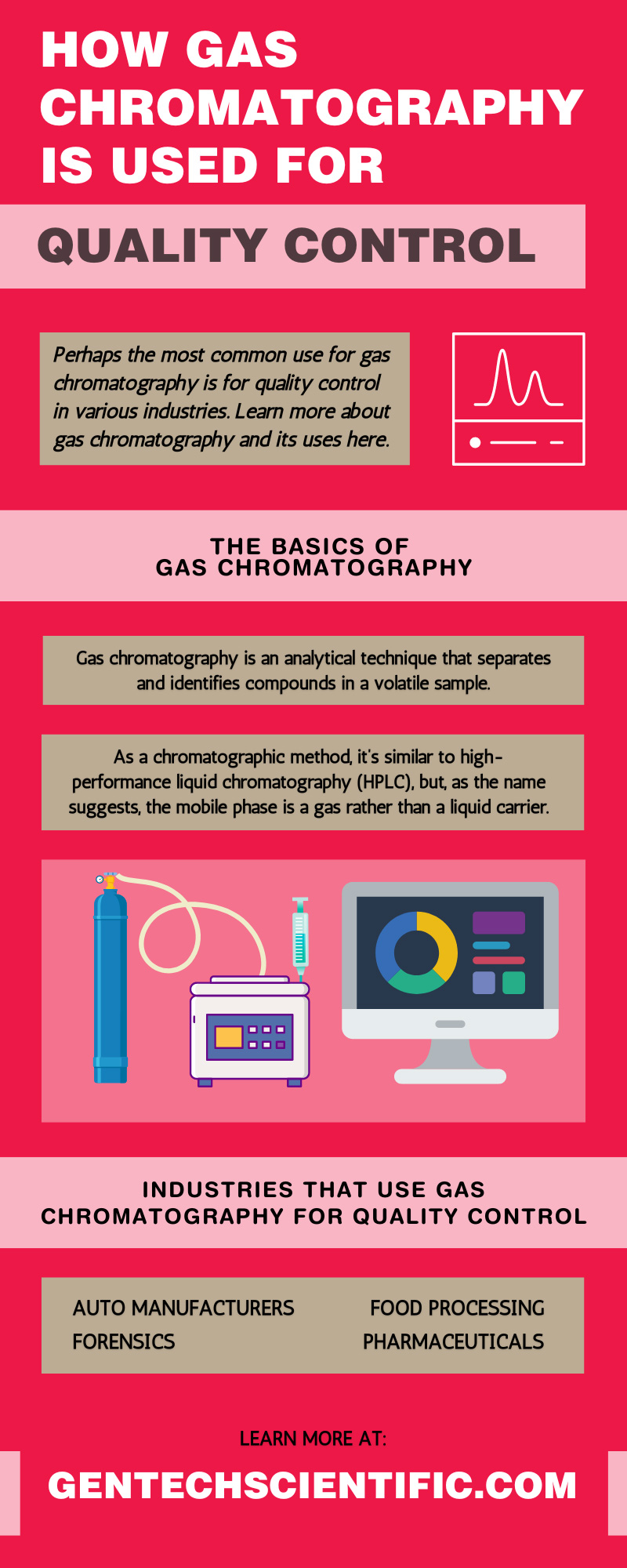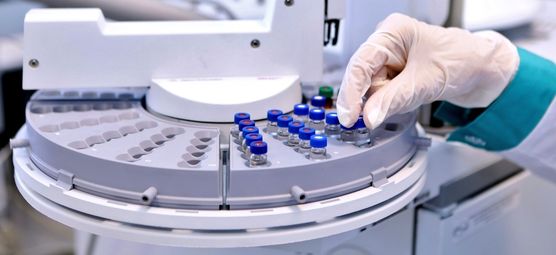Many industries use gas chromatography for various applications, but one of the most common uses for the chromatography technique is for quality control. Below, we’ll go over the basics of gas chromatography, the benefits of the method, and how it’s used for quality control purposes in various industries.
The Basics of Gas Chromatography
First, we’ll cover the basics of gas chromatography—what it is, its process, and the benefits the technique offers. Gas chromatography is an analytical technique that separates and identifies compounds in a volatile sample.
As a chromatographic method, it’s similar to high-performance liquid chromatography (HPLC), but, as the name suggests, the mobile phase is a gas rather than a liquid carrier. The separation process of gas chromatography first splits the chemical components of the mixture and then determines the presence of each component for measurement and quantification. Various industries use gas chromatography for many applications, but commonly for quality control.
The Gas Chromatography Process
We’ll briefly explain the separation and measuring process to give some background on gas chromatography. First, a small, vaporized sample gets introduced and combined with the mobile phase, known as the carrier gas. The carrier gas is typically either helium, hydrogen, or nitrogen, as they’re broadly available and won’t affect the vaporized sample.
The carrier gas takes the sample through the stationary phase, which gets made of certain chemicals that will react with the sample molecules—dependent on what compounds scientists suspect are in the sample. Once the sample goes through the stationary phase, AKA column, the compounds get separated based on their reactions to the column. The more unstable molecules move faster through the phase, while the less volatile molecules move slower. The detector then monitors, analyzes, and quantifies the chemical composition of the compounds.
The Benefits of Gas Chromatography
Gas chromatography offers many advantages because it’s a reliable analytical method for identifying unknown substances in a volatile compound. Gas chromatography is versatile and can measure hundreds of compounds, so it’s useful in many industries and applications.
Compared to other chromatography techniques, gas is much faster than HPLC, and the operational parameters of the experiment are more easily changed for quicker and more versatile analysis. Pairing gas chromatography with mass spectrometry allows for more versatility and greater identification of unknown compounds.
Gas Chromatography & Quality Control
Gas chromatography has many uses but is most commonly applied for quality control. Quality control is essential for industries that produce pure products in large quantities to ensure the products are safe for consumption and accurately labeled.
These industries must prove the purity of their products to regulators and must do so quickly and accurately—two things that gas chromatography offers. Often, industries use gas chromatography to analyze compounds to check for trace resides and contaminants in batches of products.
Industries That Use Gas Chromatography for Quality Control
Many industries utilize gas chromatography for their quality control process. Still, the most common ones that regular people are familiar with are auto manufacturers, the pharmaceutical industry, and food processors.
Auto Manufacturers
Manufacturers of all kinds use gas chromatography as a reliable form of quality control, but one that many people may not realize is auto manufacturers. It may surprise drivers that when new cars get produced, their interiors release a significant amount of volatile compounds and potential toxins.
Inside a new car, the carpets, pedals, door linings, and even seat covers can release harmful toxins into the air after manufacturing and assembly. Naturally, auto manufacturers can’t sell a toxic car, so gas chromatography gets used in the industry to detect toxins quickly and reliably in the car’s interior before they’re shipped off to showrooms.
Pharmaceuticals
Another industry that frequently uses gas chromatography is the pharmaceutical industry. Accuracy and consistency are paramount to medicine’s safety when producing pharmaceuticals. And drug-makers must prove the safety of their drugs to regulatory agencies such as the FDA, and gas chromatography is often the preferred method.
With gas chromatography, pharmaceutical companies can accurately analyze the chemical components of their drugs for a detailed understanding of the ingredients, quantity of ingredients, and purity of the product. This quality control is essential for newer drugs that move from initial testing and research to large-scale production to ensure that the medicine doesn’t change when the quantity of ingredients and scale of batches does.
Food Processing
One application for gas chromatography’s quality control that practically everyone has experienced is in food processing. The food bought and sold at grocery stores is often mass-produced and comes from just a few food production sources.
Just one contaminated batch of food could affect hundreds or even thousands of people. The food processing industry relies on gas chromatography to ensure that the food produced is free of contaminants such as pesticides, pollutants, and naturally-occurring toxins. Gas chromatography is also a quality control method for ensuring that food is fresh and has the quality of taste, smell, and texture that buyers expect.
Other Applications for Gas Chromatography
While quality control is undoubtedly a significant application for gas chromatography, it’s far from the only one. Law enforcement forensics, regulatory agencies, and sporting bodies often utilize gas chromatography. Gas chromatography can quickly and accurately identify poisons, drugs, or alcohol in a body to determine their cause of death. Similarly, GC analysis can identify performance-enhancing drugs for sporting bodies such as the Olympics.
Gas chromatography is also a common analytical method in environmental science. Environmental researchers, particularly those studying air pollution, will use gas chromatography. It’s an effective tool to identify and monitor harmful levels of pollutants in the air. This allows researchers to observe how they change and how they could affect humans, animals, and the environment.
Conclusion
As you can see, gas chromatography is helpful in many applications, from food processing quality control to forensic science. If your research or analytical lab needs quality and affordable gas chromatography instruments, consider browsing GenTech Scientific’s extensive inventory.
If you’d like to learn more about gas chromatography applications or GenTech Scientific, contact our knowledgeable staff with any questions.







